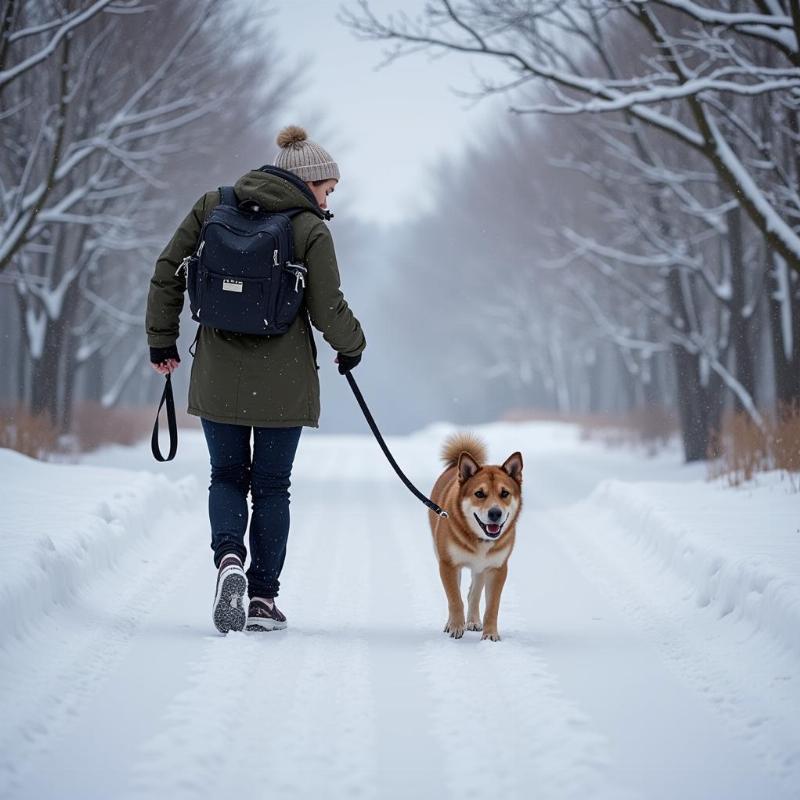Walking your dog in the winter can be a joyous experience for both of you, but it also requires special attention to your furry friend’s safety and comfort. From protecting their paws from the harsh elements to ensuring they stay warm enough, there are key considerations to keep in mind for winter dog walks. This guide provides essential tips and advice for walking dogs in the winter, ensuring both enjoyable and safe outings.
Essential Gear for Winter Dog Walks
Before you head out into the winter wonderland, make sure you and your pup are properly equipped. Just as you wouldn’t leave the house without a warm coat and gloves, your dog may need extra protection from the cold.
- Dog Coats and Sweaters: For short-haired breeds, or dogs who are sensitive to the cold, a well-fitting coat or sweater is a must. Look for waterproof options to keep them dry in snow or sleet.
- Paw Protection: Salt and other de-icing chemicals can irritate your dog’s paws. Booties provide a barrier against these irritants and also protect their paws from ice and snow. If your dog refuses booties, consider using paw balm to protect their pads.
- Reflective Gear: With shorter daylight hours, visibility is crucial. Use a reflective leash, collar, or harness to ensure your dog is easily seen by drivers.
Recognizing Signs of Cold in Your Dog
Even with proper gear, it’s important to be vigilant and watch for signs that your dog is getting too cold.
- Shivering: This is an obvious sign that your dog is cold and it’s time to head inside.
- Lifting Paws: If your dog is frequently lifting their paws off the ground, their paws may be cold or irritated by salt.
- Whining or Anxiety: These can be subtle signs of discomfort. Pay attention to your dog’s body language and behavior.
- Slowed Pace or Reluctance to Walk: If your dog is usually energetic but suddenly seems reluctant to walk, they may be getting too cold.
Adjusting Walk Times and Routes in Winter
Winter weather can require adjustments to your usual walking routine. Consider shorter, more frequent walks to prevent your dog from getting too cold. Avoid areas with heavy snow or ice, which can be difficult for them to navigate. Opt for well-lit paths and sidewalks, especially during early morning or evening walks.
Keeping Your Dog Hydrated in Winter
While it might seem counterintuitive, dogs can still get dehydrated in the winter. Make sure they have access to fresh water before and after walks. Consider carrying a collapsible water bowl and bottle on longer walks.
 Adjusting Walk Times in Winter
Adjusting Walk Times in Winter
Is it too cold to walk my dog?
Yes, sometimes it is too cold to walk your dog. Wind chill can make even seemingly mild temperatures dangerous. Use your best judgment and if you are unsure, it’s always best to err on the side of caution and keep your dog indoors.
“Remember, every dog is different,” says Dr. Emily Carter, DVM, a veterinarian specializing in canine care. “Factors such as breed, age, and health can influence their tolerance to cold. Always prioritize your dog’s safety and well-being.”
How can I protect my dog’s paws from salt and ice?
Booties are the best defense against salt and ice. If your dog won’t tolerate booties, use paw balm and thoroughly wipe their paws after walks.
“Paw balm creates a barrier between the pads and the irritants,” adds Dr. Carter. “Just remember to wipe their paws afterward, as they may lick the balm off and ingest the salt.”
Conclusion
Walking your dog in the winter can be a wonderful experience with proper preparation and attention to their needs. By following these tips, you can ensure safe and enjoyable winter walks for both you and your furry friend. Remember to always prioritize your dog’s comfort and safety.
FAQ
- How long should I walk my dog in the winter? Shorter, more frequent walks are generally better than one long walk in freezing temperatures.
- What if my dog refuses to wear booties? Try paw balm and thoroughly wipe their paws after each walk.
- What are signs my dog is too cold? Shivering, lifting paws, whining, anxiety, and slowed pace are common signs.
- How can I make winter walks more enjoyable for my dog? Try incorporating games or training exercises into your walks.
- Is it safe to let my dog off-leash in the snow? Use caution with off-leash walks in the winter, as snow can make it harder to see and recall your dog.
- What should I do if my dog’s paws get irritated by salt? Wash their paws with warm water and apply paw balm. If irritation persists, consult your veterinarian.
- Can I use human hand warmers on my dog? No, human hand warmers can burn your dog’s skin. Use dog-specific warmers if needed.
Related Articles
- best gloves for walking dogs in winter
- jacket with harness for dogs
- winter park hotels dog friendly
- dog walking upper west side nyc
Beautdogs.us is your premier online destination for all things dog-related in the US. We offer expert advice on dog breeds, care, and the best products for your canine companion. Whether you’re a new dog owner or a seasoned pro, Beautdogs.us provides reliable, comprehensive, and engaging information to enhance your dog’s life. Contact us for personalized advice at [email protected] or call us at +1 501-555-7529. Visit Beautdogs.us today!